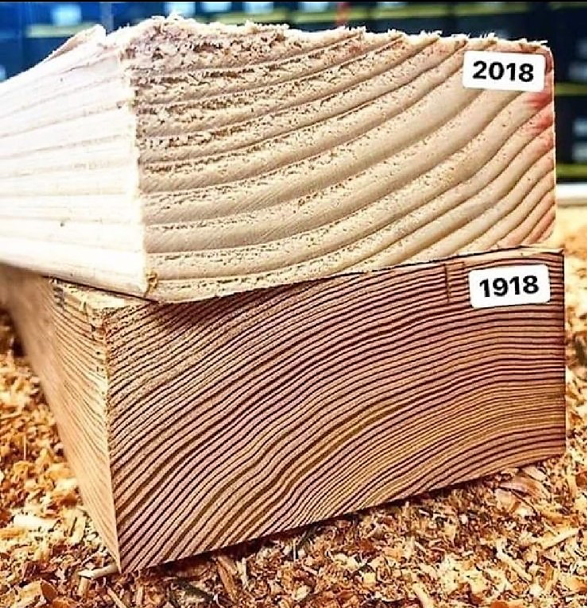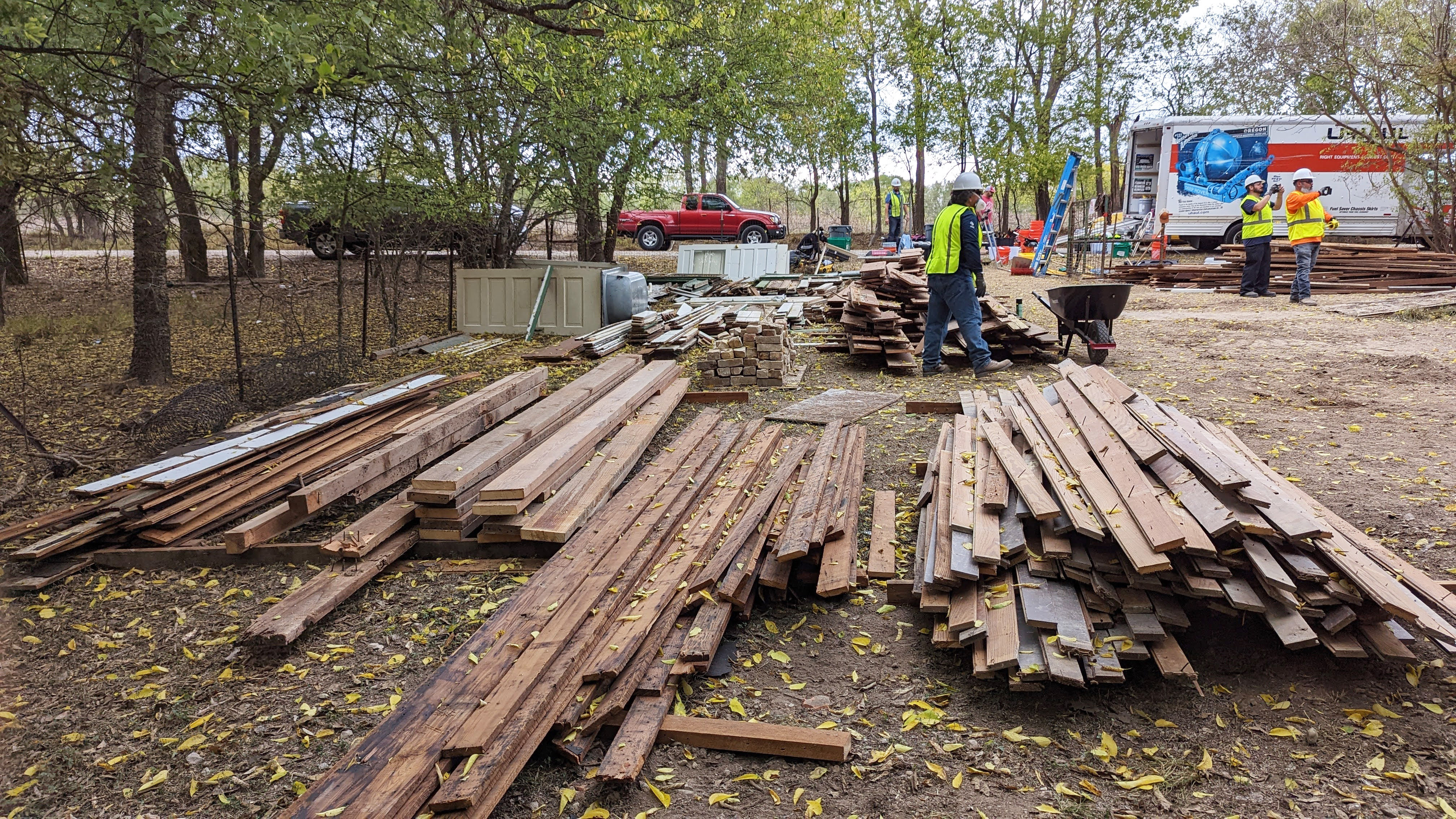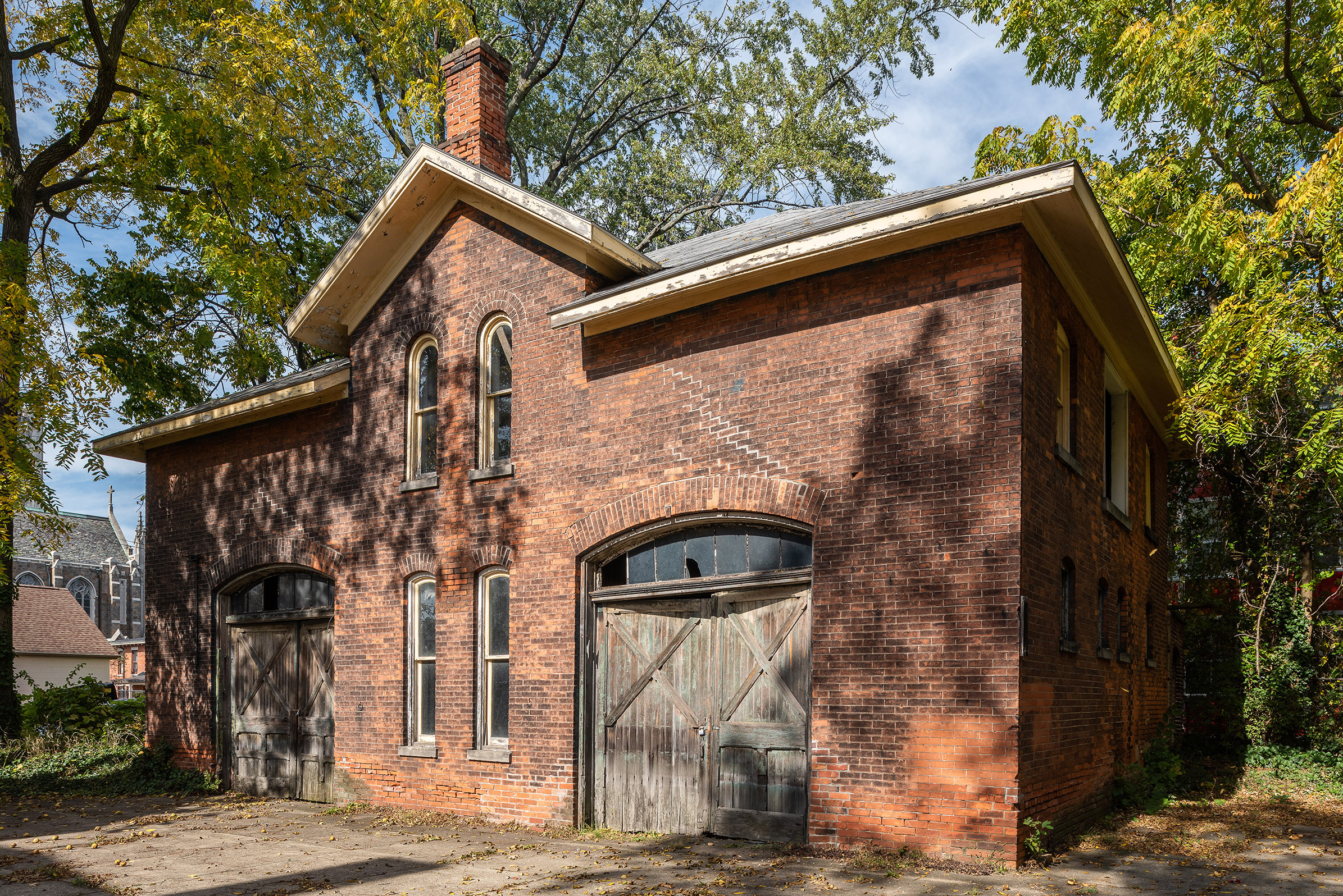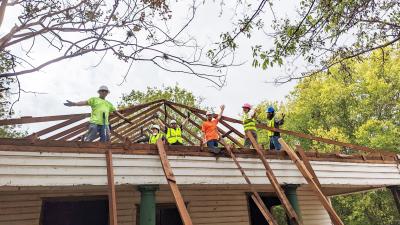It's All Connected: Deconstruction, Reuse, and Climate Change
Preservation Erie shines a green light on salvage
If you care about climate change, you should care about historic preservation.
At first glance, one might not see the immediate connection between building demolition, manufacturing of new construction materials, construction waste, and their effect on global warming and climate change — but construction and demolition waste make up over 30 percent of the entire waste stream in the United States and new construction accounts for 40 percent of the global use of raw materials, most of which are not sustainable.
I'm sure we've all noticed and/or have been inconvenienced by any number of the massive demolition and construction projects that have increasingly ramped up throughout Erie in the past few years — some of those projects are very visible and within the public eye. One can easily observe the sheer amount of waste created when a building is demolished, big or small — think Erie Coke, the former Greyhound bus station, or Erie Malleable Iron (EMI) sites alongside residential demolitions or renovations resulting in dumpster after dumpster bound for the landfill.
Quite often, a building being demolished was constructed at a time when knowledge about toxic building materials like lead and asbestos was not available. When an old building is demolished, these previously sealed and contained hazardous materials are released into the environment and become part of a global problem.
In short, the greenest building is the one that's already there.
So historic preservationists point to reuse as the best, most eco-friendly option. Use the building and the materials within it — which, depending on the year of construction, are usually of much higher quality than anything that could be affordably attained today (for example, many 100+ year old buildings are constructed with old-growth wood which is much more stable, stronger, and more rot-resistant than new growth). And there have been plenty of beautiful examples of adaptive reuse of old buildings over the years in Erie, but it is hardly the norm.
Enter Preservation Erie, a local, volunteer-run, nonprofit organization dedicated to preserving the built environment of Erie and their annual Greater Erie Awards event, where they take the opportunity to recognize the outstanding recent preservation projects completed throughout Erie County. This year they are focusing in on reuse — through both their choice of venue and keynote speaker.
The 2023 Greater Erie Awards will be held at the Erie Center for Arts and Technology (ECAT), which is a beautiful example of adaptive reuse, as the organization renovated the former Wayne School building on East Avenue, saving it from potential demolition, in order to use it for their arts education center (and, worth noting, ECAT happened to win a Preservation Erie Greater Erie Award for this adaptive reuse in 2021).
 This photo shows the stark difference between the old-growth wood often found in historic structures and new-growth wood largely used in new construction. Old growth wood is significantly stronger and less prone to rot or insect damage. (Photo: @thecraftsmanblog)
This photo shows the stark difference between the old-growth wood often found in historic structures and new-growth wood largely used in new construction. Old growth wood is significantly stronger and less prone to rot or insect damage. (Photo: @thecraftsmanblog)
Deconstruction and Circular Economy Expert Comes to Erie
The keynote speaker for the Greater Erie Awards event is Stephanie Phillips, who is the first Deconstruction and Circular Economy Program Manager for the City of San Antonio: a position housed in her city's Office of Historic Preservation. She happens to be in the only Deconstruction and Circular Economy department within a Historic Preservation office in the entire country and is leading a program of true innovation in Texas. She connects historic preservation and building/material reuse to climate change on a broad scale, and also finds their associations with overall economic growth, housing equality and sustainability, and public health.
Phillips comments on this connection between climate change and preservation: "We approach our work locally with the mindset that historic preservation and climate change are not wholly separate ideologies, professions, or areas of study, but rather inextricably linked in so many ways. At its very core, preservation seeks to steward our existing resources — both tangible and intangible — employing a very similar value system to habitat conservation. In the building industry, historic preservation can be considered the pinnacle of waste prevention."
The program that she oversees for the City of San Antonio includes their deconstruction ordinance and deconstruction contractor training program. Deconstruction is the strategic dismantling of a structure, with the intent for the materials to be reused in some way in the future. The program also oversees the city's Material Innovation Center — which attempts to focus on strategic local and regional partnerships to build the city's overall capacity to reuse more and waste less in the built environment. All of these aspects contribute to the city's goal of creating a circular economy.
So what is a circular economy? The long and short of it is this: stepping back from over-producing new materials, while at the same time saving old materials and using those instead of new materials. This feels like a radical economic concept, but in practice it makes a lot of sense. In San Antonio there is an ordinance that states that if you want to remove a building of a certain age, that building cannot be demolished in the traditional sense, rather it must be deconstructed and the salvaged materials from that building can either be reused in the new building, sold, stored, or donated.
Phillips explains, "Our program is anchored by an organ donor analogy — a structure may have reached the end of its life, but its parts and pieces could give new life to other buildings. By redirecting materials back into community use, not only are local salvage, reuse, and upcycling opportunities maximized, but the amount of materials within the marketplace increases to help repair older buildings while working to improve material affordability and accessibility at scale." We've all witnessed what happens when the price of new lumber skyrockets: the price of every project skyrockets in step. This drastic fluctuation of prices doesn't happen with reused materials.

This photo shows the wood salvaged from a deconstruction project in San Antonio, Texas. All of the materials taken out of the deconstructed building can then be reused in a new construction project – mitigating the costs (both monetary and environmental) of new materials. (Contributed)
So how does this work practically? Is there special training involved? And who pays for it? Is it more expensive to deconstruct rather than to just simply demolish? The answers are simpler than it seems. Phillips explains, "One of our local contractors says it well: the best way to learn how to construct a building correctly is to deconstruct one first. Deconstruction is the 'unbuilding' of a structure, so in many ways, the training is similar to other repair-focused construction trades, with an emphasis on removing materials carefully so they can be reused for their original purpose. When someone is trained in deconstruction, they also are trained in site safety, tool handling, material condition assessments, material identification (wood species, construction eras), material valuation, contract management, material handling, and more."
And it is through the city that these training programs are facilitated, "Our policy requires that contractors be certified through our city's deconstruction training program to be eligible to pull permits for the work." And while, on one hand the initial cost to deconstruct a building seems higher than a demolition option given the increased time and manpower involved, Phillips urges folks to look at the big picture: "I refer to demolition as a sunk cost: you are literally paying someone to throw money away, in almost every circumstance. Deconstruction affords ways to recoup costs during or at the end of a project by selling materials, keeping materials onsite to build a new project (thus mitigating new material costs), or donating them to a qualified charity for a tax benefit. Additionally, deconstruction reduces the need for heavy machinery or dumpster rentals, and mitigates landfill tipping fees."
She continues, "Comparing the cost of deconstruction using the same methodologies for pricing demolition will, on its face, seem to be more expensive, but when viewed holistically, it becomes much more competitive. That doesn't even begin to account for the public health, air quality, sustainability, material accessibility, and local economic benefits afforded by deconstruction, which also have inherent value."
How Could This Work in Erie?
San Antonio is the seventh-largest city in the country. So could such an innovative, forward-thinking program realistically be deployed in our (much smaller) City of Erie? Like many of its other initiatives, Erie's push for preservation is in its infancy but moving slowly forward, with implementation of a city-wide Historic Preservation Office and eco-conscious policies in the works. A few years ago, this began with the Historic Preservation Task Force, a volunteer committee that helped to hire a full-time employee within the city tasked with overseeing the nascent Historic Preservation Program and start putting plans into action. In terms of progress, there is currently a city-run facade grant program working in tandem with a program created to help designate historic landmark buildings or historic overlay districts (which will aid building owners in attaining local, state, and federal grant money towards restoration work). There are numerous programs funded through the Erie County Gaming Revenue Authority that provide historic preservation facade grants in different municipalities at the county level. We're getting there, preservation policy-wise. And that is the first step towards implementing the kind of deconstruction program happening in San Antonio.
Phillips feels optimistic about the potential for programs like this to take root in smaller communities. She comments, "I absolutely believe communities of all scales can shift to a culture of reuse. One of the best ways to start is to begin holding space to discuss what it might look like in Erie specifically, bringing in an intersectional group of stakeholders to start envisioning the shift. Smaller communities like Ithaca, New York and Savannah, Georgia have formed coalitions as a major first step, and other cities like Pittsburgh and Baltimore have leveraged these conversations into major actions, like an executive order from the mayor and the drafting of a deconstruction ordinance sponsored by a city councilmember."
This shift can come about as a city-wide effort, but can just as easily be initiated by non-government organizations, citizen groups, or volunteer organizations like Preservation Erie. Phillips continues, "An ordinance isn't the only tool in the toolbox. Investing in deconstruction contractor training, pursuing a deconstruction demonstration project, convening a conference or workshop, or undertaking studies are non-regulatory steps that can move the needle forward in any community."
Is Anything Similar Happening in Erie Now?
On a smaller, non-civic scale, Erie's own historic architectural expert Jeff Kidder has a lot of experience dealing with architectural salvage and reuse within his many preservation projects happening throughout Erie, but most noticeably in the West Sixth Street Historic District and near Gannon University.
Anyone passing by in recent months may have noticed that the carriage house behind the Olds-Norman house (216 W. Seventh St.) was recently deconstructed using similar principles that dictate the ordinance in San Antonio. Kidder Architects decided to deconstruct the entire carriage house brick by brick, nail by nail, as their plans involving the renovation and reuse of the adjacent home meant that the carriage house could not stay where it was.

The carriage house north of the Olds-Norman house on Seventh and Sassafras Streets, pictured here prior to its deconstruction, was taken apart brick by brick in order to salvage and reuse the materials in other local restoration projects. (Photo: RJ Fiorenzo)
Kidder comments, "Our plan is to pick up, rotate 180 degrees, and move the Olds-Norman House north to West Sixth Street after Gannon tears down Werhle Hall Dormitory the summer of 2025. The carriage house was in the way of this move and it was not realistic to move the carriage house as it did not have a basement and there was no first floor structure to hold the building together if picked up."
So rather than just scrap the carriage house altogether, Kidder made a plan to reuse it. "The hardest historic building material for us to find has been 19th century orange brick. New brick is not orange enough and typically not the exact size needed. We reused the Olds-Norman brick to reconstruct the Lowry House (453 W. 6th St.) front porch piers and we will continue to use this brick on future projects where needed. We also saved a lot of the carriage house wood framing for future use as needed." Kidder continues, "We have a salvage yard full of brick and stone and a warehouse full of salvaged doors, mantles, newel posts, and railings. We have been reusing these materials where we can."
Kidder also notes that there was no special training necessary for the construction crews to deconstruct the carriage house, just manual labor and modern construction equipment to make it go as quickly and as efficiently as possible. This kind of deconstruction and reuse is a perfect example of the work that Phillips is succeeding at on a much larger scale in San Antonio.
Another local player who has been at the salvage and reuse game for a while is the Habitat For Humanity ReStore which is located at 4922 Pittsburgh Ave. and was created by the team at the Greater Erie Area Habitat for Humanity. The store exists as a way to encourage the reuse of previously discarded or donated architectural salvage materials for use in current construction or renovation projects. Examples of materials available to purchase include doors, windows, sinks, flooring, vanities, countertops, light fixtures, paint, and furniture. This presents a great option for someone who is undertaking a renovation project and does not want to purchase new, unsustainable materials or for someone who has deconstructed/dismantled rather than demolished during a renovation project. The materials that are donated to ReStore are then sold for reuse — the funds going towards helping Habitat for Humanity reach their housing goals in the community.
Obviously, construction companies who are used to the old ways of demolition and new construction will not necessarily willingly switch over to deconstruction and reuse of materials, they will need to be nudged either through policy creation or through the inability to ignore the issue any longer (i.e., extreme climate related issues becoming much more urgent). But small steps in the right direction, by bringing deconstruction into the conversation, may help create a gradual shift to the direction of reuse.
More Information About the Greater Erie Awards
If you'd like to attend the 2023 Greater Erie Awards to hear Stephanie Phillips give her presentation entitled "Circular Heritage: Leveraging Reuse for a Sustainable Future" and to join the board of Preservation Erie in congratulating their 11 award recipients this year, the group invites you to purchase your ticket from their website at preservationerie.org. The event will take place at ECAT (650 East Ave.) on Thursday, Sept. 14 at 6 p.m. Tickets are $25 which includes heavy hors d'oeuvres and refreshments provided by Dinner is Served by Lisa. Sponsorship information is available by emailing info@preservationerie.org
Erin Phillips, who serves as the secretary of the board of Preservation Erie, is beyond excited to listen to Stephanie Phillips (no relation) speak at the 2023 Greater Erie Awards. She can be reached at erin@eriereader.com




